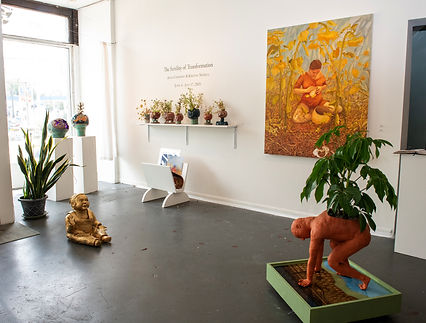



CAN Article:
The Fertility of Transformation: Anna Chapman and Kristen Newell At Waterloo Arts
Author: Kayli Salzano
Emerging from a period of global “inaction times” wherein we had all been ordered to shelter in solitude, Anna Chapman and Kristen Newell turn to nature and text to locate themselves in a shared web of renewal. Many of us have found new ways in the past year to negotiate the tension between “action” and “inaction.” We’ve reassessed and realigned, we’ve scrambled only to wait, and we’ve claimed our openness to change—but have we dedicated energy to listen and to experience without active response?
Chapman’s practiced experience in wildcrafting, herbalism, and healing work and Newell’s deep interest in folklore, fable, and literary tradition intersect to identify the body as a site of constant emergence and entanglement. In their joint exhibition, The Fertility of Transformation, the two welcome the garden into the gallery with paintings and sculptures that foreground composting as a metaphor for universal transformation.
The gallery, lined with dry organic matter and living plants, has a tender and humming presence. Together, Chapman’s and Newell’s painted and sculpted figures survey time passed and call forward to time that lies ahead. Kristen Newell’s life-size ceramic figures populate the open floor, the clay forms standing as fossils that record instances of human awareness and respite. A particularly fragmented and architectural form, Figure, stands over seven feet tall on its base with its hands clasped atop its head. Its collar and chest are dotted with windows, and staircases spiral up both its legs into its hollow abdomen. Its face is neatly cut away, but rests perpendicular to its surface, perhaps beside itself, nestled halfway inside the round cavity of its own head.
As we move around the piece, we see glints of light through the figure’s hollows, and we can almost imagine the sound of wind whistling through its core. The figure’s boundless receptivity forges an identity in constant flux, an identity with the potential to hold many or none at all.
The mammoth Ancestor of Maize, an ink drawing by Anna Chapman displayed on the back wall of the gallery, provides a vast backdrop to Newell’s sculptures. The work on fabric, stretching almost ten feet wide, paints a figure reclining at ground level and facing upward to a blotted, starry sky. The figure lies among a neat row of dried corn stalks that sprout from a dense network of tiny roots underground. The roots mingle with the figure’s limbs and hands, causing the outlines of the crop, earth, and body to overlap, evidencing a complete entanglement of human and environment.
The image recalls the ancient Mesoamerican conception that food forms the bridge between humans and the structure of universal realms. Manipulation and cultivation of maize, specifically, was believed to exemplify humanity’s influence on the structure of the cosmos, and likewise, the cosmos’ influence on humans. To grow and to nurture, and then to share, process, and consume demonstrates a rhizomatic transfer of energy that entangles all members within a larger, unified network.
Chapman and Newell have chosen Octavia Butler’s words to frame the exhibition. As quoted from Parable of the Sower: “All that you touch, You Change. All that you Change, Changes you. The only lasting truth Is Change.” The exhibition’s collective warmth, then, becomes tangible matter and subject of the show. The sunny hues of Chapman’s Between Worlds vivify tender pink bodies in Coming Into, Learning Behind, and the implied processual warmth of Newell’s fired clay meets the humid breath of living plants in the space. The heat required to initiate a transformation is fully present, in which case we as visitors are the matter undergoing change.
Waterloo Arts Gallery opens its Summer 2021 season with The Fertility of Transformation at June’s Walk All Over Waterloo. To read more about Waterloo Arts’ summer programs, including The Green Palette and Waterloo Arts Fest, visit waterlooarts.org.
THE FERTILITY OF TRANSFORMATION | JUNE 4–JULY 17
Works by Anna Chapman and Kristen Newell




River
2020, 25” x 20” x 46”, Ceramic, glaze, beeswax, dirt.
Rivers feed life, carry news, forge paths, swell and flood the landscape; they are peaceful, violent, and essential. There are rivers of the underworld, Tao, flow, lineage. I was feeling chaotic with news, loss, and the pandemic, I wanted to put those feelings into a grounded figure, allow them some physical weight. The color scheme is intended to suggest a stone figure sitting in a river up to their armpits. The river flowing around them represents the chaos and the salve. The gesture is of still observation, the plant is the fruit, the growth, it brings life to the piece and requires water.



Husk
2019, 35" x 35" x 7'9", ceramic, glaze, wood, steel, grout, epoxy.
I formed the feet of Husk around my feet as an exercise to sooth myself after a traumatic loss. In the beginning of my grief I had to keep moving to gain enough distance to find perspective, it felt like trudging up an endless staircase. The distance I needed was in time, and I worked tirelessly on this large figure to fill it. A tree representing life force, natural and rough, grows through temple forms in the abdomen, breaking apart a linear grid in the chest. The grid is a metaphor for my human constructions, barriers, and projections that could not contain the realities of nature. The figure looks outward, with arms above its shoulders, hands clasped on the head, if light threw a shadow, the arms and head would create an eye shape. The face swings open to let the energy free, the real substance of the work is no longer in the sculpture, husk refers to the figure left behind, like an exoskeleton, cocoon, shell, or abandon city.

